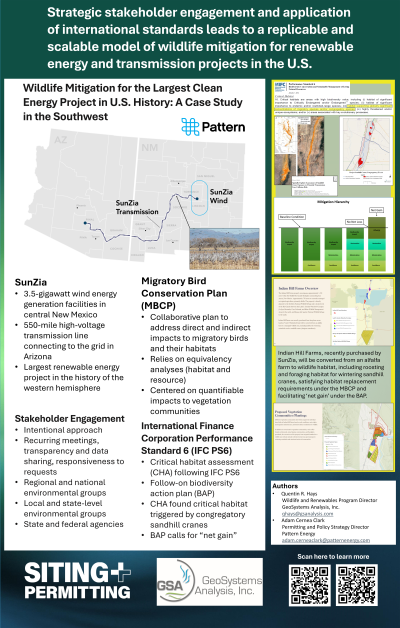Wildlife Mitigation for the Largest Clean Energy Project in the United States: A Case Study


Quentin R. Hays
Senior Wildlife Ecologist / Wildlife and Renewables Program Director
GeoSystems Analysis, Inc.
Corvallis, Oregon
Poster Presenter(s)
The SunZia Wind and Transmission project (Project), being developed by Pattern Energy, is the largest clean energy infrastructure project in United States history, comprising a 3.5-gigawatt wind energy development and accompanying 550-mile high-voltage transmission line. A multi-year environmental review, permitting, and financing process led to the development of robust mitigation for the Project, including a novel, Project-specific Migratory Bird Conservation Plan (MBCP). The MBCP, developed with the U.S. Fish and Wildlife Service (USFWS), identifies direct and indirect impacts to migratory birds created by the Project. In addition, during the financing process, the Project conducted a Critical Habitat Assessment under International Finance Corporation Performance Standard 6 (IFC PS6) and a follow-on Biodiversity Action Plan. Implementation of the MBCP, as well as “no net loss” and “net gain” requirements under IFC PS6, led to the purchase of an 1,100-acre working alfalfa farm along the Middle Rio Grande in New Mexico. This property, known as Indian Hill Farms, will be converted to functional wildlife habitat focused on wintering waterbirds over a period of years and donated to the USFWS or New Mexico Game and Fish Department; during the restoration process the property will be held by The Conservation Fund. Successful restoration of Indian Hill Farms will satisfy habitat restoration requirements under the MBCP, as well as requirements for net gain of sandhill cranes under the Project Biodiversity Action Plan, the only species for which critical habitat impacts were identified under the IFC PS6 Critical Habitat Assessment. This presentation will describe the environmental review, permitting, and financing process for the Project, including mitigation planning, outline how the restoration of Indian Hill Farms will satisfy conditions under both the MBCP and IFC PS6, and detail how the Project can serve as a replicable model for other renewable energy and transmission projects in the U.S.
